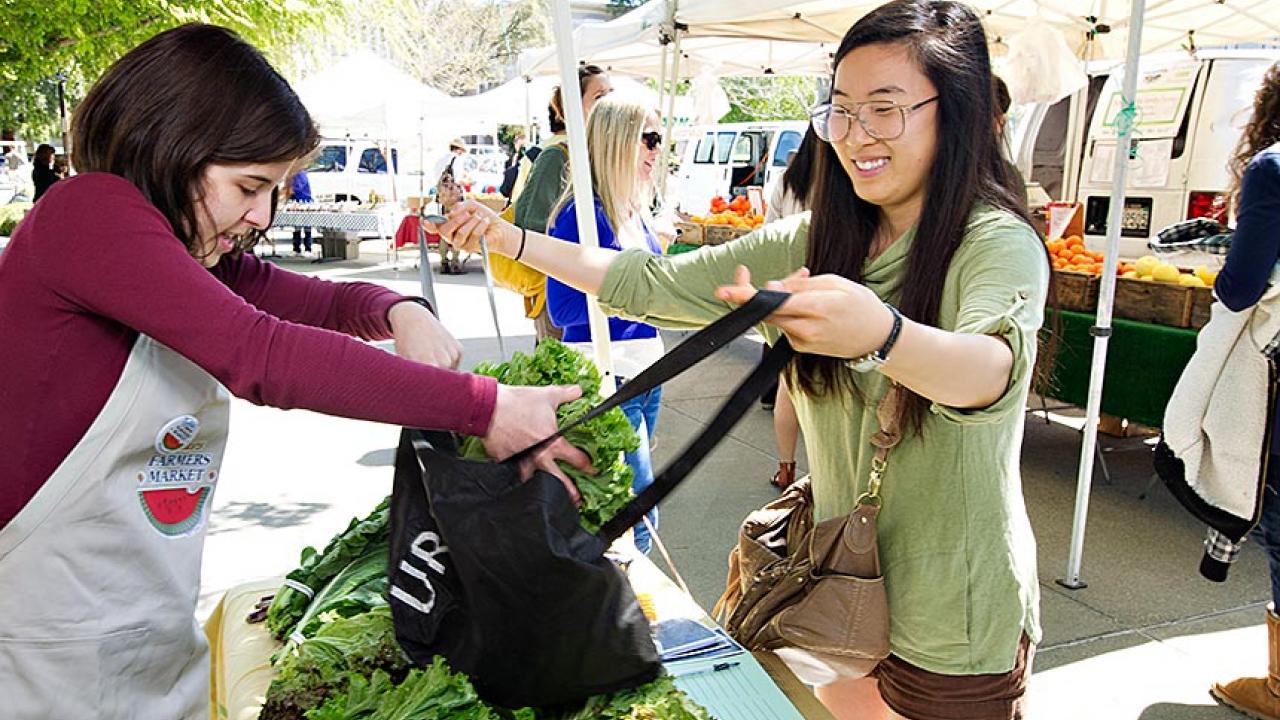Quick Summary
- Positive impact of direct marketing has ripple effects in regional economy
- Direct marketing includes farmers markets, roadside farm stands and community-supported ag programs
- Regional policies should nurture direct-market food producers
Sacramento-area farmers and ranchers who sell their products directly to consumers generate twice as much regional economic impact per dollar of output as do area food producers who don’t engage in direct marketing, reports a UC Davis agricultural economist and a team of UC Cooperative Extension researchers.
The newly released study of the four Sacramento region counties of El Dorado, Placer, Sacramento and Yolo found that direct-marketing food producers had a regional output multiplier of 1.86 compared to just 1.42 for producers not involved in direct marketing.
Direct-marketing channels include farmers markets, roadside farm stands and community-supported agriculture programs that provide consumers with regular deliveries of farm products.
“The direct marketers make up a relatively small part of the Sacramento region’s agricultural sector, but this study demonstrates that these food producers generate both economic and qualitative benefits for the region,” said study leader Shermain Hardesty, a Cooperative Extension agricultural economist in the UC Davis Department of Agricultural and Resource Economics.
“It’s important that the economic contributions of direct-marketing farmers and ranchers be taken into consideration so that regional policies can be enhanced to support and nurture the growth of these food producers,” Hardesty said.
The regional economic impacts identified in the study are threefold: revenue received directly by the agricultural producer; a ripple effect when the food producer purchases inputs in the region; and a secondary ripple when the producer and the suppliers of goods and services to the producer, in turn, spend more money in the region on household goods and services.
The report, along with separate economic impact reports specifically for El Dorado, Placer and Yolo counties, is available online.
Sacramento region direct marketers
In the four-county Sacramento region, direct-marketing food producers are a relatively small segment of the total agricultural sector, accounting for 19 percent of the region’s farms and only 4 percent of its agricultural production.
The direct-marketing farm operations tend to be smaller and more labor-intensive, and source more of their inputs locally than do nondirect-marketing operations in the area.
The new study was based on economic information gathered from 88 local farmers and ranchers, including 31 vegetable farmers, 48 orchard or vineyard growers and nine livestock producers, each of whom generated at least $1,000 in annual sales from marketing directly to consumers.
After the data were collected, they were incorporated into an economic modeling program to estimate the economic impacts of producers engaged in direct marketing.
Study highlights
Other findings from the report include:
- Sacramento region direct-market producers averaged just $164,631 in one year of sales compared to $568,105 for those not engaged in direct marketing.
- Seventy-three percent of the direct marketers also sold through wholesale channels.
- Overall, the direct-market producers generated 44 percent of their total revenues through direct-marketing channels, 55 percent through wholesale channels and 1 percent through commodity markets.
- For every $1 million of output, the direct-market producers generated a total of 31.8 jobs in the Sacramento region while the nondirect-market producers generated only 10.5 jobs.
- Direct marketers purchased 89 percent of their inputs within the region while the nondirect-market producers purchased 45 percent of their inputs in the region. This local sourcing of inputs was the primary factor responsible for the direct-market producers having a greater economic impact on the region than nondirect-market producers.
Collaborators and funding
Hardesty collaborated on the study with Libby Christensen, Erin McGuire, and Gail Feenstra, all of UC Davis; and Chuck Ingels, Jim Muck, Julia Boorinakis-Harper, Cindy Fake and Scott Onetto, all with the UC Cooperative Extension.
Funding for the study was provided by the University of California Division of Agriculture and Natural Resources Competitive Grants Program.
Media Resources
Shermain Hardesty, Agricultural and Resource Economics, 530-752-0467, shermain@primal.ucdavis.edu
Pat Bailey, News and Media Relations, 530-219-9640, pjbailey@ucdavis.edu
